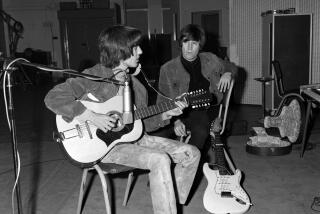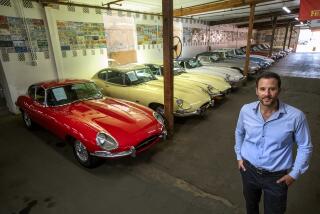Pedal Power
VENTURA — If he could, if he had the money for it, pawnshop owner Larry Kelmanson would collect big, old cars--classic cars like a 1950 Cadillac convertible.
Instead, he owns a cherry, 1950 red-and-white “Kidillac” convertible--a metal toy pedal car that he rescued from rusty oblivion. It now sits alongside dozens of the other pedal cars stuffed into his East Thompson Avenue shop.
“I’d like to have the kind of car collection they have at Harrah’s. But I don’t have the money, so I collect pedal cars,” he said.
The 54-year-old Kelmanson has trouble even giving a rough estimate of the number of small, sleek beauties he’s picked up over the years.
When asked, he sputters: “Dozens . . . over 100. . . . Actually, I don’t know how many.”
The toys, just big enough for a 3-year-old to squeeze into, went out of fashion with children and manufacturers more than two decades ago, Kelmanson said.
In his view, they provide a snapshot of a time when people appreciated fine lines and curves on big machines.
*
Although some pedal cars can still be found, there are far more plastic Big Wheels and larger motorized electric toy cars and trucks--also plastic--for toddlers to wheel around in today.
For Kelmanson, that’s sacrilege. He shuns anything plastic.
He got into pedal cars when his oldest son, Lou, was a toddler--picking up the little toys at swap meets and garage sales or rescuing them from decay and abandonment in someone’s yard.
“It’s true--he loves cars, and over the years he’s dabbled in collecting antique cars. He’s had Packards and Cadillacs, some limos,” said Lou, now 31. “I think that’s part of why he collects them, but I also think the cars give him a flashback to when he was a kid.”
Like a lot of adults who collect toys, Kelmanson grew up poor and did not have many as a child, his son said.
“If you knew where he came from, you’d understand,” Lou said. “Considering all the challenges he went through in his life. I mean, he grew up on the streets of Chicago and L.A., and he made something of himself. Maybe he’s remaking a childhood he didn’t have.”
*
There was a short time when Kelmanson, as a kid in Chicago, owned a small pedal airplane. But it was stolen by another boy when Kelmanson left it unguarded in his front yard.
“Man, I wish I had that thing today,” he said.
As a car aficionado, Kelmanson likes pedal cars that are modeled after their real counterparts--old Model-Ts, Packards, Cadillacs and Plymouths, for instance.
Pedal cars come in all shapes and sizes. The most common are the pedal tractors, Kelmanson said. Those don’t fetch a lot of money, but the rare International version of the tractor can be worth up to $15,000.
Although Kelmanson buys pedal cars, he has never sold one. He either keeps them or gives them to friends and family members. His collection includes a mix of vintage classics and rarities like a “Woody” from the 1920s, a pedal car built in the Soviet Union and modeled after an old gas guzzler, and a miniature motorboat with trailer.
“Back then is when they made real cars,” he said. “When you saw a Cadillac, you knew it was a Cadillac. Those cars were distinctive. Now cars are all alike.”
Although he does not own any, there are also pedal cars that are complete with fake engines, hoods and doors that open, lights that work and shock absorbers.
“These were expensive when they were new. So of course they’re worth a lot of money,” he said.
*
His collection occasionally attracts other pedal car enthusiasts, who stop by the store to look. He does his own share of traveling just to see other collectors’ cars.
“Pedal cars are like fine art or Art Deco to me,” he said. “I’m like any collector who appreciates good art.”






